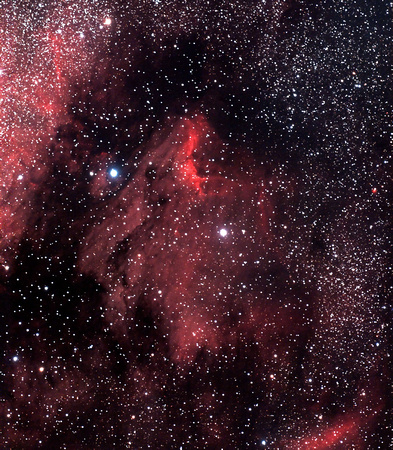Other Names: The Pelican Nebula
Optics: Borg Astrograph 101ED at f/4.1
Mount: Atlas EQG using The Sky6 and EQMOD
Camera: Canon EOS 50D [ UV/IR filter modification by Hap Griffin ]
Filters: IDAS Light Pollution Suppression (LPS) Filter
Exposure: 125 Mins [25 x 300s at ISO 800]
Accessories: Auto guided with Borg 45ED and Orion Starshoot Auto guider using PHD
Location: Sicamous, BC
Date: July 17, 2010
Notes: Processing: Image acquisition with Maxim DSLR. Image calibration, align, and combine in Maxim DSLR. Levels, curves, crop and resize in Photoshop.
Calibrated w/36 Darks, 40 Bias, 22 Flats using light box
Ambient temperature was between +12.2C and +14.4C
This photo was selected as "Picture of the Day" on the Anactores Telescope page August 10th, 2010
http://www.buytelescopes.com/Gallery/ViewPhoto.aspx?pid=39608It also tied for 1st place in the Central Alberta Astro-Photographers August 2010 contest.
The
Pelican Nebula (also known as
IC5070 and IC5067) is an H II region associated with the North America Nebula in the constellation Cygnus. The nebula resembles a pelican in shape, hence the name. The Pelican Nebula is a large area of emission nebula in the constellation Cygnus (the Swan), close to Deneb, and divided from its brighter, larger neighbour, the North America Nebula, by a molecular cloud filled with dark dust.
The Pelican is much studied because it has a particularly active mix of star formation and evolving gas clouds. The light from young energetic stars is slowly transforming cold gas to hot and causing an ionization front gradually to advance outward. Particularly dense filaments of cold gas are seen to still remain. Millions of years from now this nebula might no longer be known as the Pelican, as the balance and placement of stars and gas will leave something that appears completely different.


